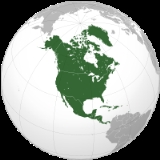
and almost wholly within the Western Hemisphere
. It is also considered a northern subcontinent
of the Americas
. It is bordered to the north by the Arctic Ocean
, to the east by the Atlantic Ocean
, to the southeast by South America
, and to the west and south by the Pacific Ocean
.
North America covers an area
of about 24,709,000 square kilometers (9,540,000 square miles), about 4.8% of the planet's surface or about 16.5% of its land area.
1497 John Cabot lands in North America at Newfoundland leading the first European exploration of the region since the Vikings.
1527 The first known letter from North America is sent by John Rut while at St. John's, Newfoundland.
1535 French explorer Jacques Cartier sets sail on his second voyage to North America with three ships, 110 men, and Chief Donnacona's two sons (whom Cartier had kidnapped during his first voyage).
1583 Sir Humphrey Gilbert establishes the first English colony in North America, at what is now St John's, Newfoundland.
1620 The ''Mayflower'' departs from Southampton, England on its first attempt to reach North America.
1620 The Pilgrims sail from Plymouth, England, on the ''Mayflower'' to settle in North America. (Old Style date; September 16 per New Style date.)
1652 Rhode Island passes the first law in North America making slavery illegal.
1670 King Charles II of England grants a permanent charter to the Hudson's Bay Company to open up the fur trade in North America.
1679 The brigantine ''Le Griffon'', commissioned by René Robert Cavelier, Sieur de La Salle, is towed to the south-eastern end of the Niagara River, to become the first ship to sail the upper Great Lakes of North America.
1683 William Penn brings 13 German immigrant families to the colony of Pennsylvania, marking the first major immigration of German people to America.

